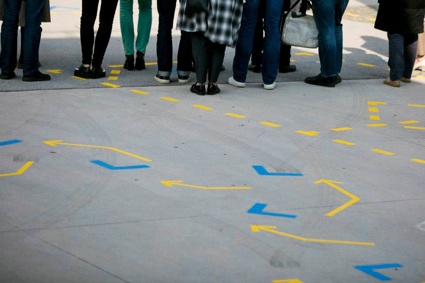 Giuditta Vendrame and Paolo Patelli (La Jetée), Friction Atlas. Photo: BIO50
Giuditta Vendrame and Paolo Patelli (La Jetée), Friction Atlas. Photo: BIO50
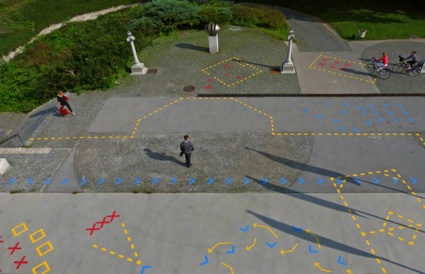 Giuditta Vendrame and Paolo Patelli (La Jetée), Friction Atlas
Giuditta Vendrame and Paolo Patelli (La Jetée), Friction Atlas
One of the themes of the BIO 50 design Biennial which opened last week in Ljubljana looked at the simple act of walking in the city. Several designers explored walking under various guises and lenses but i was particularly interested in the street markings, research and performances of Giuditta Vendrame and Paolo Patelli from design and research studio La Jetée.
The designers logged into a Friction Atlas some of the rules and constraints that regulate the circulation of citizens within urban space. For example, any reading or picnic gathering over 20 persons in one of New York city parks requires a special event permit. In Sweden, you need to apply for a permit to dance in public. In Cairo you’re allowed to spontaneously discuss public matters only if you are fewer that 10 people.
Giuditta and Paolo drew 1:1 diagrams onto the pavement to illustrate rules that control the use of public spaces in cities such as Genoa, Cairo, Washington, Stockholm, Sydney, etc. They then invited the public to perform staged choreographies while discussing issues of public space, law and legibility.
Friction Atlas addresses the issue of legibility of public space, its programs, and the laws that regulate its uses. Many regulations discretize human behavior, tending to be algorithmic, quantitative and invisible. Sometimes they are rigorous and mathematical, other times loose and under-defined. They are textual, prone to contested interpretations. Friction Atlas aims to make regulations – that are always implicitly present in any public space – explicit and visible, through graphical devices.
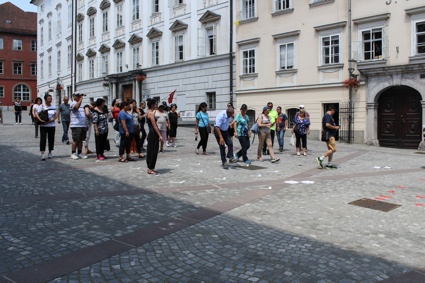 Giuditta Vendrame and Paolo Patelli (La Jetée), Friction Atlas. Test in Ljubljana. Photo: BIO50 / The Agency of Walking
Giuditta Vendrame and Paolo Patelli (La Jetée), Friction Atlas. Test in Ljubljana. Photo: BIO50 / The Agency of Walking
I can’t resist a project that makes the dynamics of authority not only visually but also physically discernible, so i contacted the designers to discuss their work for the BIO 50 biennial (proper report on the event will be on your desk. One day):
Hi Giuditta and Paolo! Could you explain what you mean when you talk about the algorithmic quality of these regulations that govern the use of public space?
Regulations are nothing but symbols, conventions, but they have the power of persuading human beings to act. When they are put to work, they make things happen. They are sets of instructions that incorporate power, while responding to internal and external conditions. They are a kind of invisible structural force that plays through into everyday life.
In the context of public space, a number of legal prescription can generate differences in the displacement, mobility and assembly of bodies. Citizens perform in their everyday a synchronized routine of elaborate moves on public surfaces. We recognize, in such patterns, a choreography.
Assembling in public space to discuss, demonstrate either support or opposition, publicize a cause, mark or commemorate an event is both an individual and a group activity. Figures and routines involve interplay and sometime synchronization. The use of public space is choreographed not only to the organizer’s intentions, but also to abstract regulations. As sets of instructions, algorithms are rules. They are abstract, but always implicitly present in any public space. These prescriptions extend way beyond exceptional events, and pervade our everyday urban experience thoroughly. Regulative rules exist for picnicking in a park in New York City, for group dancing in Sweden, for kids to return home in Iceland. For example, it is not uncommon to see in the media demonstrators keeping their march to one line, standing on the sidewalk, always fewer than fifty, in front of the White House.
The idea of making such instructions legible on public ground, came to us last April, while we were in Cairo. We were greeting a group of Egyptian friends, just outside a bar in Talaat Harb, Downtown. Suddenly, one of them grinned, realizing that – according the recently introduced Egyptian anti-protest law – we were being illegal. Giuditta and I immediately thought of what it means to be a group of ten people. How do you define it? How do you recognize it? Where are the thresholds to be found in our mutual interactions? Of course such relations extend to our online presences.
Indeed, in recent Cultural and Media Studies, as in the writings of Scott Lash and Alexander Galloway, the phrasing “algorithmic rules” has been associated to new forms of power, that reside in the networks, computers, information, and data, rather than being exerted from above by legitimate institutions. Paolo Gerbaudo used the expression “choreography of assembly” while analyzing the online organizational structures and process of the recent urban revolutions in Egypt, USA and Spain.
Our project is more basic. It is on the ground perhaps that a wide range of phenomena can be recognized at their maximum degree of visibility.
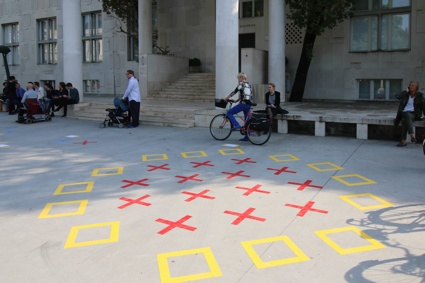 Giuditta Vendrame and Paolo Patelli (La Jetée), Friction Atlas
Giuditta Vendrame and Paolo Patelli (La Jetée), Friction Atlas
How do you (and citizens living in a particular city) find out about these regulations?
We started asking friends who are living in different cities and countries if they were aware of legal prescriptions that regulate the use of public spaces. Sometimes they would tell us anecdotes or they would suggest us to look for specific events on the news. For example Marko Peterlin recalled of a protest in Koper, which couldn’t take place because the Slovenian law states that the organizers of any public event must always have with them a written agreement with the owner of the land where they want to assemble. In that case, protesters meant to express their disagreement with a local policy, through a demonstration on public ground. The problem then was that “public” means owned by the Municipality and managed by the local government. This resulted in a weird short-circuit, which we also tried to visualize.
We subsequently met with NGOs, with lawyers, we had meetings with the local police, and with public officials. While collecting anecdotes, listing procedures, and saving titles from the local news, we also started looking into the actual codes. We photocopied and downloaded when possible City Ordinances, Public Order Acts, Police Regulations, Park Regulations, even Children Protection Acts, from different cities and countries. Across these documents, we searched for numbers, quantities, distances, conditions, predicates. We searched for the abstractions that shape our public behaviors, to represent them visually.
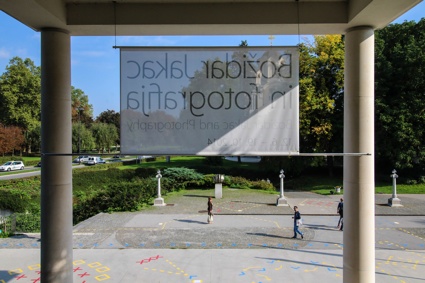 Giuditta Vendrame and Paolo Patelli (La Jetée), Friction Atlas
Giuditta Vendrame and Paolo Patelli (La Jetée), Friction Atlas
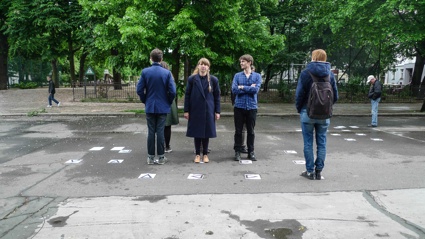 Giuditta Vendrame and Paolo Patelli (La Jetée), Friction Atlas. Test in Berlin. Photo: BIO50 / The Agency of Walking
Giuditta Vendrame and Paolo Patelli (La Jetée), Friction Atlas. Test in Berlin. Photo: BIO50 / The Agency of Walking
Paolo, i read on your online page that you worked with Urban Sensing. That project relies a lot on digital technologies and is generally quite sophisticated. Friction Atlas, on the other hand, is pretty low tech: diagrams on the floor and walks. Why did you make the project so ‘tangible’, instead of having an app for example?
In code as much as in regulative rules, objects – even people – are abstracted. They cannot be known in themselves or in their being. Things are only known through their predicates, their “quantified” qualities. Citizens, as individuals or groups, are measured for their number, the noise they make, the age they have, the distance they keep, the money they have paid. Against the abstract, the mathematical, it is the real that embodies resistance. The materiality of the street, and of walking, are the natural media for making this tension tangible. They are also the best sites for opening a discussion which needed to be im-mediated. The street, in fact, afforded unexpected interactions of the public with our graphic devices, beyond what we had planned and designed.
We wanted to turn the physical context into an open playing field, or a loose game board, and keep the experience ambiguous. We posed an invitation to play, while valuing the uncertainty of the status of the performance as game. Taking part to a choreographed debate about regulative rules on the use of public space, by enacting such rules in a real public space, raises questions: Is this a game? Are we playing? Which role am I playing?
In the street, the boundary between being in and out of the game is blurred, and so are the social boundaries between who is playing and who is not. Our diagrams represent strollers, as well as protesters and policemen, but the player identity and the normal everyday identity always somehow overlap.
The sort of game we propose, at the same time playful, ironic and highly serious, has no goal – only rules, which without context, interpretation and the active participation of the visitors would exist only as static code, as ready-made, found predicates.
Keeping a 1:1 scalar ratio with the human body is central to affording this interplay and to really make the rules legible on the ground. It also helps maintaining different levels or engagement, from the superficial interaction of kids and cyclists, to the concerned reading of students and people with a bit more time.
Do you see Friction Atlas as a continuation of Urban Sensing, or is that a totally different approach to the urban environment?
We are getting accustomed to seeing the behavior of the citizens – users, customers, consumers – of any given city represented through spectacular real-time maps and data visualizations.
Our attempt this time was to look through our transparent society to try to visualize the other side. Rather than in a bird’s view on the city, we were interested in looking to what’s above it.
I certainly see Friction Atlas as a reflexive continuation of the work I have done in Urban Sensing, and at MIT’s Senseable City Lab. As other projects and prototypes developed in the last couple of years – from my research residency at the Copenhagen Institute of Interaction Design, to a number of workshops, including at SALT Institute in Istanbul, and at Strelka Institute in Moscow – it shows a more critical edge. Central to all of them, anyway, is the transformation of data into fully visible (or sometimes audible) agents, in order to provide a possible model for opening up to new forms of civic and aesthetic engagement with hidden or abstract layers of the city. Even when – to say it again with Scott Lash – information is not *in* society or related *to* society, but it *is* society, and vice versa, the focus on space offers a tangible – and therefore debatable – representation and an embodiment of such immaterialities as code or law. The city is a mirror of the current society and culture.
Finally, but very importantly, in the case of Friction Atlas, Giuditta and I have worked together as “La Jetée“. She has an encompassing fascination for invisible borders and flows, and has worked in the recent past with legal loopholes and related paradoxes. We believe that design has a lot of space for experimentation in these areas. How can it cope with invisible things? Sometimes ideas can be expressed very simply.
I’m also interested in the term ‘friction’ in the title? Where do you locate this friction?
The friction we wish to represent in our atlas is to be found in space, on the ground. Within the contemporary city, a plurality of processes and logics converge in the same sites. The sites extend to our own lives, to our desires and perspectives.
Densely weaved dispositions – more or less integrated, more or less coordinated – inhabit the same space we live in. Our everyday experience of the urban cannot be understood but in relation to other processes, other dimensional scales. The encounter between these different logics happens on contended ground, hence the friction. The security paradigm followed by many cities worldwide is inscribed in space, the commodification of our historical heritage is inscribed in space, the media bubble that surround global events is inscribed in space. The visibility of the battlegrounds, of the exceptional event – as argued among others by Andrea Mubi Brighenti – shows and proves the importance of the infra-ordinary in its invisibility. We don’t sample from different cities in order to show specific conflicts, but because we are interested in the pervasivity of minor and daily frictions.
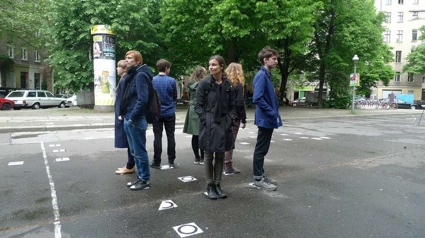 Giuditta Vendrame and Paolo Patelli (La Jetée), Friction Atlas. Test in Berlin. Photo: BIO50 / The Agency of Walking
Giuditta Vendrame and Paolo Patelli (La Jetée), Friction Atlas. Test in Berlin. Photo: BIO50 / The Agency of Walking
Is this an ongoing archive? or will Friction Atlas end with the biennial?
The diagrams represent cases from different cities, including Cairo, Genoa, London, Ljubljana, New York City, Rome, Stockholm, Sydney, Washington. We definitely want to continue with this research, add more cities, involve more people, expand the discourse. Comparisons between cities, countries are particularly enlightening: try with Singapore and Egypt, or with USA and Iceland. You would be very surprised. The installation in Ljubljana, together with an edited collection of comments, short interviews, excerpts from articles and public acts, constitute our notes towards a critical atlas.
We set up a tumblr, to start collecting external contributions: do you have any anecdote, article, or thought that you would like to share?
You can do it on the beta version of the Friction Atlas archive: http://frictionatlas.net/
We would also like to bring our research further by moving beyond prescriptive rules, and including other formal strategies that define “a priori” the possibilities – and the impossibilities – of movement (e.g. public transportation trajectories). Making tangible the invisible text of such implicit rules – which are biopolitical rather then disciplinary – would define – in the words of Andrea Mubi Bringhenti – subjective environments, or horizons, rather than traces and routes.
This is a big challenge, as we really want to keep all the levels of engagement present, especially the most playful.
Thanks Giuditta and Paolo!
Friction Atlas was developed by Paolo Patelli and Giuditta Vendrame for the Agency of Walking, BIO 50. The 24th Biennial of Design is open in various locations around Ljubljana until 7 December 2014.
Also part of BIO 50: Engine Block. Or how to turn a moped into a boat or a concrete mixer.
